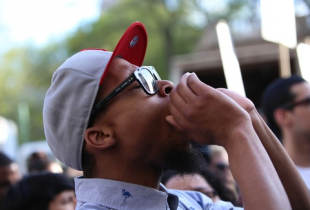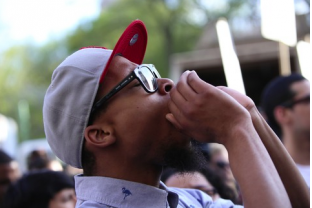
What is happening in America? The city of Milwaukee in the State of Wisconsin was convulsed in violence after the fatal shooting of a black man by police officers on August 13. The riot went on for two days.
Milwaukee is a powder keg. Long histories of racism combined with recent incidents of police shooting held the city on edge. “It’s a series of things that have happened over a period of time,” said Sharlen Moore, who runs Urban Underground, a non-profit group committed to ending violence in communities of colour. “And right now,” says Sharlen Moore, “you shake a soda bottle and you open the top and it explodes. This is what it is.”
Sharlen Moore’s statement from 2016 echoes that of writer James Baldwin’s declaration from 1960. In the heart of urban poverty in America, wrote Baldwin, rage festers. Tension increases and the police appear more and more like an occupying army. “One day, to everyone’s astonishment,” wrote Baldwin, “someone drops a match in the powder keg and everything blows up.” It is the “astonishment” that rankled Baldwin. How can one be innocent of the social crisis in urban America? A riot ensues. “Before the dust has settled or the blood congealed,” Baldwin noted, “editorials, speeches and civil-rights commissions are loud in the land, demanding to know what happened. What happened is that Negroes want to be treated like men.”
At 3.30 p.m., Milwaukee police stopped a car with two young black men, who, the officers later said, appeared to be suspicious. Twenty seconds into the traffic stop, one of the young men, Sylville Smith, was shot in the chest and arms. The police said that he ran, had a gun in his hand and pointed that gun at the policemen. He died immediately. The other man was arrested. Smith is one of the 600 Americans killed by the police so far this year. Last year, 990 people were shot dead by the police.
The names of police officers who have killed people, many of them disproportionately black men, are worn like a talisman by protesters: Darren Wilson, Timothy Loehmann and Jason van Dyke. “The police have long accepted that they are above the law,” says Bakari Kitwana, an activist and journalist who directs Rap Sessions. Rap Sessions has collaborated with Milwaukee’s Urban Underground to hold conversations about race, police violence and poverty. “The recent high-profile videotaped police killings where officers get away with murder have emboldened police officers across the country in their belief that their job description includes serving as judge, jury and executioner no matter how slight, real or imagined the infraction,” Kitwana told me.
Smith was not unknown to the law. In 2014, he was arrested for carrying a concealed weapon. It should be noted that he was never arrested on a felony charge —namely a crime that involved violence. His crimes were mostly for poor driving (carrying a gun is not a violent crime in the United States). Smith was a suspect in a shooting in 2015, but the judge in the case dismissed the charges against him. Smith’s sister, Sherelle, said that the officer who shot her brother knew him from when they were young. “He didn’t like my brother,” she said. “The officer had a career, but my brother was more popular. He used to harass Sylville.”
The officer who shot Smith is also black. Goddess Mathews, a community activist, said “a black man did the shooting, but he was wearing a blue uniform with a badge. He represented the mentality that people around here are less than human. We’re enemies of the state.”
Goddess Mathews’ views are widely shared in Sherman Park, the neighbourhood of Milwaukee that is at the epicentre of this incident. Unemployment rates are hard to calculate here. Schools are in great distress. Violence is under the surface. “A public policy agenda hell-bent on elite wealth accumulation at the expense of the majority poor has, ironically,” says Kitwana, “politicised a defiant generation whose brand of resistance insists that the criminal justice system will no longer have the last say.”
With the collapse of the economy came a transformation of the state. The main institution that interacts with the community is the police. Milwaukee police chief Edward Flynn says that his officers are not trained to deal with the kind of social crisis that pervades his city. What is implied by Flynn’s statement is that his officers are not social workers. They do not know how to help people solve their everyday problems. The police seem, therefore, as an occupying army. That is why Goddess Mathews uses such strong words—“We’re enemies of the state.” American elites, says Kitwana, “still imagine that they can escape an economic plan to ease the suffering of the majority poor and working class. I expect more Milwaukees,” he tells me sadly.
The riots over Smith’s death follow major protests that took place after the shooting by the police of Dontre Hamilton in 2014. Hamilton, who suffered from mental illness, was shot 14 times by a police officer. He was not charged with murder. He was merely dismissed from his job. It was a police officer with a gun rather than a social worker that came to tend to Hamilton. After Hamilton’s death, the Black Lives Matter protests took hold of the city. These demonstrations included families frustrated over the everyday disrespect they faced from the police and the close to 2,000 high school students who walked out of school onto the streets out of solidarity with Hamilton. “It is grassroots activists in Milwaukee,” says Kitwana, “who stepped up to help youth process pain and channel rage that comes with the realisation that their citizenship is tentative and America has failed them.”
“We are summoned here,” Reverend Darius Butler of the Tabernacle Baptist Community Church said at a protest in Milwaukee, “because of America’s unfinished business with respect to its citizens of African descent.” This was an echo of Baldwin again—we are here, he seemed to say, to demand that we be treated as humans.
Meanwhile, as if to add insult to injury, Republican presidential candidate Donald Trump came to a mostly white community—West Bend, Wisconsin—to berate the black community for its support of the Democrats. “Those peddling the narrative of cops as a racist force in our society, a narrative supported with a nod by my opponent [Hillary Clinton],” Trump said, “share directly in the responsibility for the unrest in Milwaukee and many other places within our country.” Trump said he wanted African Americans to vote for him, but from the location where he spoke; he seemed to want to use the unrest to underline his position on “law and order”. It is toughness that is his policy—more police and more jails. Trump poked directly at the raw nerves in Milwaukee.
During the 1964 elections, Governor George Wallace of Alabama ran for president on a racist ticket. He went on a tour of the northern States, including Wisconsin, where he was warmly received in sections of the State. Debates in Milwaukee at that time over civil rights brought this confirmed racist to campaign against “racial integration”. On April 1, Wallace went to the south side of Milwaukee and spoke on behalf of segregation. Two African Americans were in the hall. When the national anthem played, they did not get up, and one of the other speakers pointed to them. “Send them back to Africa,” someone shouted. One of Wallace’s supporters had the microphone. He said of African Americans: “They beat up old ladies, they rape our women folk. How long can we tolerate this?” It was incendiary rhetoric. It replicates in its particulars the events of Trump rallies. Little seems to have changed. But demography is against both the racists and Trump. They simply do not have the numbers behind them.
Resources of Hope
President Barack Obama’s Department of Justice has done important studies of the police departments of Ferguson, Cleveland and Baltimore—all three epicentres of police violence and civic unrest. Each report showed that reform of the police seems very difficult. “Change has been too slow,” Obama said in July, “and we have to have a greater sense of urgency about this.” But Obama also admitted that police reform was a long-term project. He had no means to hasten the pace. The White House Task Force on 21st Century Policing signalled the need for “culture change”—a way to talk about the need to end racism.
Trump’s opponent, Democratic presidential candidate Hillary Clinton, straddles the Black Lives Matter sentiment and her support for “law and order”. This is an impossible position to take, but it is familiar to the Clintons. When Bill Clinton was the President, he pushed a draconian Crime Bill in 1992 alongside an end to welfare. There was harshness here. But Bill Clinton never paid for it. He was still able to draw on consistent support from the black community. Hillary Clinton is heir to that support base, and yet she is eager for the moderate Republicans for whom the taste of “law and order” is mother’s milk. Standing before a largely white crowd in Pennsylvania, Hillary Clinton said, “Look at what’s happening in Milwaukee right now. We’ve got urgent work to do to rebuild trust between police and communities and get back to the fundamental principle: Everyone should have respect for the law and be respected by the law.” These are words vague enough to mean anything.
The emergence of the Movement for Black Lives and other such platforms has sent another, clearer, message to the country. They demand change now. These groups have developed economic platforms, which include revitalisation of black communities, which will be funded by reparations for slavery. A new book, Policing the Planet: Why the Policing Crisis Led to Black Lives Matter edited by Jordan T. Camp and Christina Heatherton, makes the point that no solution can come from the policing crisis unless the inequality crisis is resolved. Massive investment in the police has come as jobs have vanished and social networks have been underfunded. Patrisse Cullors, one of the founders of Black Lives Matter, tells Heatherton in the book that the time has come to imagine the abolition of the police. “There’s an amazing campaign happening in New York that is calling on our movement to reclaim the idea of public safety as access to jobs, healthy food, and shelter—in other words, having a framework that is about the community’s response to social ills instead of a police response to social ills.”
Vijay Prashad is professor of international studies at Trinity College in Hartford, Connecticut. He is the author of 18 books, including Arab Spring, Libyan Winter (AK Press, 2012), The Poorer Nations: A Possible History of the Global South (Verso, 2013) and The Death of a Nation and the Future of the Arab Revolution (University of California Press, 2016).















